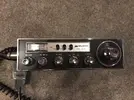TM - Thanks for that but I'm looking for the chart that equates channel and crystal combination.
Yeah, that's not in the Sam's. Which means we have to use math, darn it.
The M15 6000 kc (6 Mhz) xtal is used to generate your TX signal by mixing with one of the 4xxx kc (4.xxx Mhz) and one of the 37/38 Mc (MHz) xtals. Quick look the frequencies involved allows for a guess that we're probably going be subtracting the 4 and 6 Mhz signals from the 37 Mhz ones.
We already know 6 Mhz is always there in TX. So let's grab the frequency of M5, 4.635 Mhz, and add it to the 6.000 MHz so we only have to do one subtraction at the end. 6.000 + 4.635 = 10.635.
Now, grabbing the frequency of M6, 37.600 Mhz, we can subtract the number we just got from the prior addition operation above. 37.600 - 10.635 = 26.965
And 26.965 MHz is the frequency of channel 1.
As a formula it would look something like this:
Xtal1 - ( 6.000 Mhz + Xtal2) = operating frequency
M12, M13, and M14 are only used on receive. M13 provides the basic 455 kHz for the receive IF, with M12 and M14 being slightly offset higher and lower to provide the delta tune function.
If you get a number that can't possibly exist in your radio, like 27.245, that just means the crystals can do it but you don't have a channel selector position for that channel.
Hopefully that makes sense. I'm running on about 2 hours of sleep today. But I think with the information provided you should be able to generate your own xtal chart.

